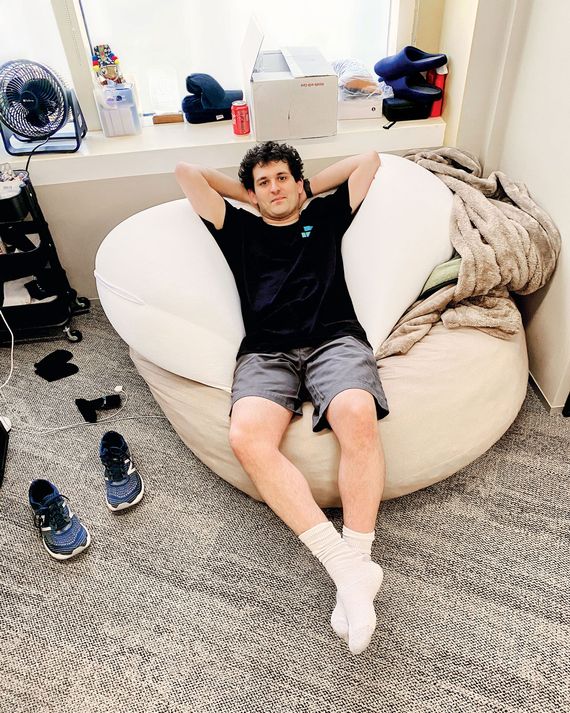Sam Bankman-Fried on Cryptocurrency and Donating to Biden

Sam Bankman-Fried on his office beanbag chair, where he sleeps most nights.
Photo: Victor Llorente
In January 2018, Sam Bankman-Fried, then a mathy 25-year-old who had recently left Wall Street to try his hand at buying and selling cryptocurrency, spotted a fabulous arbitrage: Because of a faddish surge of interest in Japan, bitcoin was trading for 10 percent more there than in America. Much of the rest of the cryptosphere was distracted by something even shinier — the 30 percent price gap between Korean and American bitcoin, known as the kimchee premium. But Korea has a restricted currency that’s hard to turn back into dollars; Bankman-Fried had tried to crack that trade, at one point calculating whether it made sense to get an airplane, fill it with people, and fly to Seoul to all buy bitcoin in person. Instead, he settled for Japan. It was still complex (or “quite annoying,” in his words) to execute at scale, but Bankman-Fried and some friends, with whom he had founded a trading firm in Berkeley called Alameda Research, cobbled together a chain of intermediaries, including obscure banks in rural Japan, to take advantage of the monthlong price discrepancy. They moved up to $25 million a day. “You can do the math,” said Bankman-Fried. “That was the craziest trade I’ve ever seen.”
When Bankman-Fried and I spoke over FaceTime recently, it was 10 p.m. in Hong Kong. The lights of the city were visible out the window of his high-rise office, where he presides over a fledgling crypto-empire. Alameda, which turns over $2 billion a day, ranks No. 10 on the BITMEX leaderboard of all-time most-profitable traders. Bankman-Fried now spends most of his time building a second business, called FTX — a high-volume, low-fee platform for trading derivatives like options and leveraged tokens — which Mike Novogratz, the hedge-funder turned crypto-enthusiast, recently described as “the most innovative exchange out there.”
Bankman-Fried’s gaze kept drifting off-screen, and there was a persistent clacking sound. I assumed he was answering emails, until he held up a first-anniversary FTX novelty coin, which he’d been spinning, and a deck of cards, which he’d been shuffling. “I’m compulsive,” he said. He wore a gray hoodie, and his hair was somewhat less cloudlike than it appears in most public photos. Bankman-Fried, who shares an apartment with roommates and baffled U.S. political observers with an enormous donation to the Biden campaign this past fall, estimates his net worth at a mostly illiquid $10 billion.
His rapidly attained wealth is the product of a long-nurtured utilitarian worldview. The son of public-spirited law professors at Stanford, Bankman-Fried was drawn early on to the Benthamite ideal of the greatest good for the greatest number of people. His attempts to live the philosophy first found expression when he considered factory farming: “It’s a chicken being tortured for six to eight weeks so we can spend half an hour eating it,” he said. “That makes no sense.” (He became a vegan.) Later, Bankman-Fried stumbled upon the Effective Altruism movement and an offshoot with the credo “earning to give,” which promotes pursuing a lucrative career in order to have more money to give away. To that end, after graduating from MIT, he became a quant at the trading firm Jane Street Capital, which enabled him to donate to organizations devoted to animal welfare and the possibly existential threat of artificial intelligence.
Eventually, Bankman-Fried quit and — after a stint working for the Centre for Effective Altruism (a U.K.-based charity) — became a full-time investor in crypto, then an inescapable topic on Wall Street. It was an immature, inefficient industry, and a year after Alameda’s Japanese trade, he sensed another big opportunity to bring some discipline to the general chaos of the marketplace. He moved to Hong Kong in late 2018 to start FTX.
Until then, Bankman-Fried’s involvement with politics had been limited. In 2012, he had blogged a little, typing out Nate Silver–inspired thoughts on the dollar value of a single swing vote, and in 2016, he’d spent a day canvassing in Pennsylvania, going to the homes of registered Democrats, expecting cheerful gratitude. Instead, “Their eyes would be saying Fuck you,” he recalled. “Those who’d say anything basically said, ‘I hate both candidates. I hate that you’re making me make this choice. I hate that you’re making me talk about this. I want my privacy back. I wish I didn’t live in a swing state.’ ”
In 2020, Bankman-Fried was in a position to do a lot more than knock on doors. After some more math — once again, he quantified the value of swing votes and evaluated the most efficient way to make an impact — he approached Future Forward USA, a super-PAC affiliated with the Facebook co-founder Dustin Moskovitz. Bankman-Fried gave more than $5 million to Biden and groups supporting him, which helped fuel a nine-figure, eleventh-hour blitz of TV advertising. The transaction — which he says was motivated less by specific issues than by the Biden team’s “generic stability and decision-making process” — landed him in the No. 2 spot on a Wall Street Journal list of CEOs backing the candidate.
Being…
Read More: Sam Bankman-Fried on Cryptocurrency and Donating to Biden
2021-02-02 13:30:00
